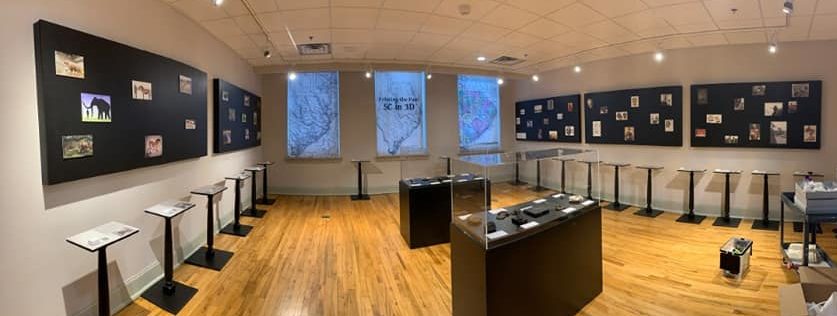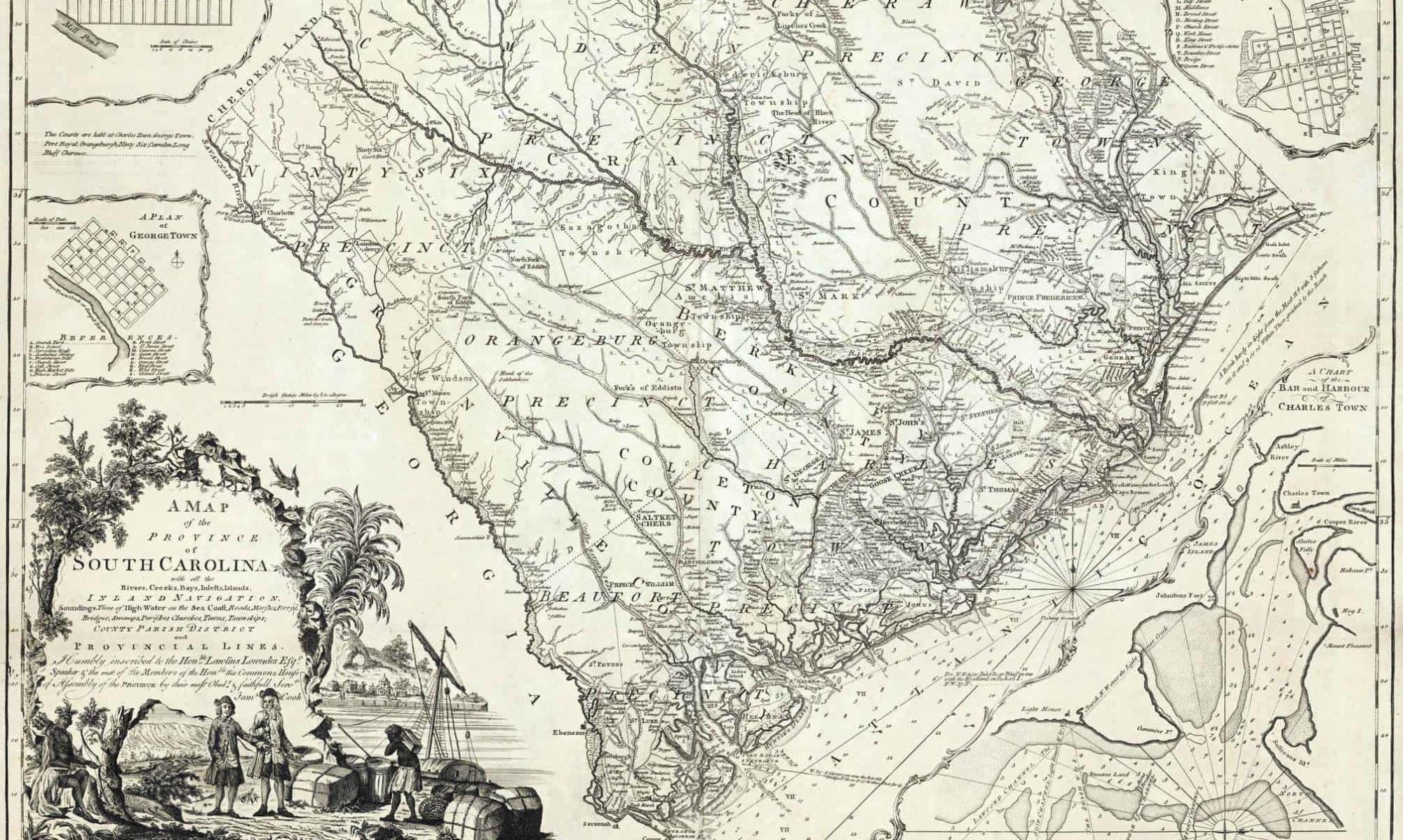Please enjoy our digital exhibit, audio, images, interpretive text, and more here.

Printing the Past: SC in 3D is an exhibit that features 3D scanned and printed artifacts in a hands-on display spanning Horry County’s prehistory and history, with audio and braille interpretation for all audiences.
The exhibit allows all museum-goers to discover a sample of the material culture and natural history of Horry County, but unlike traditional exhibits, makes replicas of the objects available for everyone to touch and explore. Please read, listen, and touch in this exhibit and enjoy learning about Horry County’s past!
Baby Mammoth Tooth (Mammuthus columbi)
This baby mammoth tooth was discovered in the 1980s in the Intracoastal Waterway in Horry County. The Columbian Mammoth (Mammuthus columbi) lived during the Pleistocene (the Ice Age) epoch which lasted between 1.8 million to 10,000 years ago. The Columbian Mammoth was over 14 feet tall at the shoulder, and may have weighed over 10 tons. Unlike their cousin, the Wooly Mammoth, the Columbian Mammoth had little hair. Changes to climate and environment, as well as human hunting pressure, at the end of the last ice age may have driven mammoths to extinction. Did you know the Columbian Mammoth is the state fossil of South Carolina? (Accession #2017-37-40)
Fossil Horse Foot (Equus sp.)
Did you know that wild horses lived in South Carolina during the last Ice Age? Fossils provide our evidence, such as this complete, two-piece horse toe fossil found along the bank of the Waccamaw River. It represents an extinct member of the Equus genus that lived here during the Pleistocene more than a million years ago. All horses in North America went extinct about 10,000 years ago. The horses that we have today are descended from those brought with early explorers and colonists in historic times. (Accession #2012-37-63)
Fossilized Horse Jaw and Tooth (Equus sp.)
During the Pleistocene epoch, many animals that are now extinct roamed across Horry County, South Carolina. This fossilized horse jaw fragment was a surface find on the Intracoastal Waterway given to the Horry County Museum in 2012. Pleistocene horses were members of the Equus genus and lived here more than a million years ago. All horses in North America went extinct at the end of the last ice age. The horses that we have today are descended from those brought with early explorers and colonists in historic times. (Accession #2012-37-42)
Beaver Skull (Castor canadensis)
Did you know that beavers are the largest rodents in North America? They live in and around water, and have a paddle for a tail and webbed feet for swimming. This beaver skull was found near the Waccamaw River, in Conway, South Carolina. Beavers cut down trees and build dams, creating ponds and wetlands that are good for the environment. Humans hunted and trapped them for their fur, almost causing them to become extinct, but today, beavers are returning and you may even see one in Horry County!
(Accession #2018-13-181)
Eastern Hercules Beetle (Dynastes tityus)
The Eastern Hercules beetle, a member of the scarab beetle family, is one of the largest beetles on Earth, and can grow up to 2.5 inches long. The beetle comes in a variety of colors and shades ranging from black to green, and uses its coloring as camouflage. Male members of this beetle family have distinctive horns on their heads that are used for fighting when competing for a mate. It’s been suggested that their larvae would be a great protein source for humans. Would you like to eat a beetle burger?
(Accession #2007-3-1)
Carolina Anole (Anolis carolinensis)
The Carolina anole, more frequently referred to as the American chameleon, is not actually a chameleon at all. Although this lizard can change colors from vibrant green to mottled brown, the change results from the anole’s mood and temperature, not its surroundings. When threatened, the anole may lose its tail as an escape mechanism, as has happened to this particular example. Anoles eat insects and spiders, and most typically fall prey to birds, other reptiles, and, sometimes, the neighborhood cat.
(Accession #2006-97-80)
Stone Projectile Point
This spear point feels like it might be deadly, doesn’t it? The Native American ancestors of the Waccamaw Indian people of Horry County made projectile points like these thousands of years ago. They were used for hunting and hafted to the tips of spears. This particular point is made of rhyolite and probably dates to the Archaic period, meaning it could be as old as 8,000 years! This spearpoint might have never seen action due to its unique curve, making it unable to fly correctly. (Accession #2017-17-7)
Native American Pottery
Do you store your food in plastic tupperware? In prehistoric times, you would have had to make your own storage containers out of clay. The ancestors of the Waccamaw Indian people of Horry County, South Carolina, made these three styles of pottery sherds found on archaeological sites:
– Thoms Creek Punctate (2000-1000BC): rectangular indents in horizontal rows made with a reed before firing.
– Deptford Linear Check Stamped (600BC-500AD): grid pattern across the surface made with a carved wooden paddle before firing.
– Irene Incised (1450-1550AD): grooved lines and arches incised along the rim of the vessel.
(Accession #2016-10-107, 110, 180)
Native American Chunkey Stone
Chunkey Stones are handcrafted, rounded, and smoothed stones used in a popular game called Chunkey. Players rolled stones along a shallow ground trench, while competitors aimed to hit the moving stones with spears or arrows. Although Chunkey is commonly attributed to the tribes of upstate South Carolina, this rare find from Horry County could indicate the practice of Chunkey or trade with ancestors of the Waccamaw Indian people. This artifact shows an ancient practice of entertainment and social culture within South Carolina’s Native American communities. (Accession #2005-41-1)
Native American Steatite Pipe
This late prehistoric Native American pipe is a unique hand-crafted piece of art constructed of steatite, also known as soapstone. The pipe is adorned with a repetitive carved circular pattern along the bowl. The Horry County museum received the pipe in two pieces from a local farm. The museum then repaired the pipe and placed it on display with other artifacts. The ancestors of the Waccamaw Indian people used pipes like these for smoking tobacco and other plants during ceremonies and gatherings. Did you know that Native American people were the first to farm tobacco in Horry County? (Accession #2007-16-6)
Padlock
This padlock was found at the bottom of Waccamaw River in Horry County. It was made between the early 1700 to mid-1800s. The padlock may have been used for many different things: perhaps it anchored a fishing net and was lost at the bottom of the river, or it may have secured a trunk of valuable items on a boat travelling upstream. The padlock is still in good condition, though it has some erosion from the river. It has a symbol on the front of the padlock that some may think looks like Chauncey, the Coastal Carolina University mascot.
(Accession #2003-003-0023)
Trephine
Imagine this: a soldier is rushed into the hospital tent with head trauma. He has taken a severe blow from the butt of an enemy Springfield rifle. Pressure needs to be relieved, so the field surgeon utilizes his trusted trephine to drill a small hole in the patient’s head. Trephination was a technique that used this hand-held drill to bore a hole in the patient’s skull to drain blood and pus, and relieve pressure. This surgical procedure is ancient and used from prehistoric Mesoamerica to Medieval Europe, but this one is from Civil War era Horry County, South Carolina.
(Accession #2012-7-10)
Civil War Hat Pin
Hat pins were not usually seen on the battlefield during the Civil War. Instead, soldiers wore these pins on their hats at formal events as a marker of their position in the cavalry, artillery, or infantry. The pin is decorated with a bald eagle holding an olive branch and a bundle of arrows. The eagle looks toward the olive branch, which signifies peacetime. Pins similar to this one may have been worn at a wide range of formal events by soldiers in South Carolina.
(Accession #2013-23-12)
Civil War Era Hearing Aid
This ear trumpet, made by an unknown craftsperson in the late 1800s, paved the way for modern-day hearing aids. It is one solid piece that has two components: the bell and the ear tube. The creator made the bell and ear tube out of brass and topped the ear tube with rubber for the user’s comfort. Due to its small size, the user could carry the ear trumpet around to capture more sound and for better directionality. This hearing aid was donated by Mary Ellen Scarborough of Horry County. (Accession #2017-16-2)
20th Century Match Case
Dr. C. J. Epps owned this ornate sterling silver match case. Epps was the first licensed pharmacist in Horry County, and he opened the Conway Drug Company on Church Street in 1902. Matches are a common item, but today’s are strikingly different than those used in previous centuries. Those contained all the chemicals for ignition in the match head and could be ignited by striking on most hard, dry, and rough surfaces. Match cases were used to hold these matches, preventing them from igniting on other items, like coins, in one’s pocket. (Accession #2003-013-87)
World War One Victory Medal
Pearly Herbert Lambert, a Conway native, was awarded this World War One victory medal by the U.S. government for service between April 6, 1917 and November 11, 1918. It is made of bronze and silk. The back of the medal states “The Great War For Civilization” and lists the Allied Forces countries. There are two inscribed clasps on the silk ribbon, which highlight the reason for Lambert’s award. The top states “Meuse-Argonne,” for service in France, and the bottom “Defensive Sector.” (Accession #2018-20-12)
WWI Aviator Goggles
Pilots wore goggles in the First World War to protect their eyes while flying. The Myrtle Beach Daedalians, an organization that preserves the memory of our military’s ace pilots, dedicated these goggles to Elliot White Springs. During WWI Springs was a member of the British 85th Squadron and one of the most daring pilots in history. The Myrtle Beach Daedalians honor and celebrate him as a heroic pilot in First World War. (Accession #2015-21-13)
Toy Soldier – World War I Radioman
This is a toy soldier made by the Gray Iron Casting Company from cast-iron in the 1930s. Radiomen during WWI sent and received messages on the battlefield. The manufacturer of this toy crafted the radioman from iron instead of the then-standard lead and sold it “blank” to let the child decorate it themselves; unusual at the time among toymakers. This piece was donated by Ethrulia Dozier of Conway to the Horry County Museum in 1985.
(Accession #85-113-2)
This exhibit was produced by Coastal Carolina University students in History 392: Museums & Communities and Anthropology 432: Cultural Resource Management, under the direction of Assistant Professor M. Katie Clary and Professor Carolyn Dillian.
Funding was provided by South Carolina Humanities, a not-for-profit organization; inspiring, engaging, and enriching South Carolinians with programs on literature, history, culture, and heritage; and by a Public Outreach grant from the Southeastern Archaeological Conference.
Thank you to Coastal Carolina University, the Horry County Museum, and members of the community for their assistance and support of this project.
